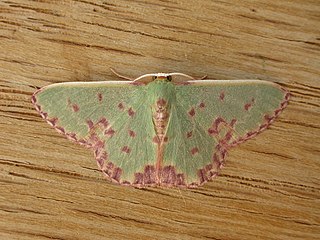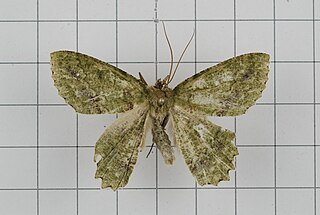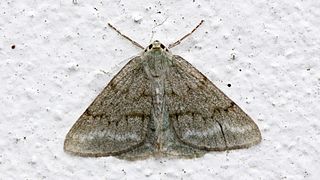
The geometer moths are moths belonging to the family Geometridae of the insect order Lepidoptera, the moths and butterflies. Their scientific name derives from the Ancient Greek geo γεω, and metron μέτρον "measure" in reference to the way their larvae, or inchworms, appear to measure the earth as they move along in a looping fashion. A very large family, it has around 23,000 species of moths described, and over 1400 species from six subfamilies indigenous to North America alone. A well-known member is the peppered moth, Biston betularia, which has been subject of numerous studies in population genetics. Several other geometer moths are notorious pests.

Ennominae is the largest subfamily of the geometer moth family (Geometridae) with some 9,700 described species in 1,100 genera. They are usually a fairly small moths, though some grow to be considerably large. This subfamily has a global distribution. It includes some species that are notorious defoliating pests. The subfamily was first described by Philogène Auguste Joseph Duponchel in 1845.

Geometrinae is the nominate subfamily of the geometer moth family (Geometridae). It is strongly split, containing a considerable number of tribes of which most are presently very small or monotypic. These small moths are often a light bluish green, leading to the common name of emerald moths, though a few species called thus are also found in the tribe Campaeini of the Ennominae. In 2018, a phylogeny and classification based on a molecular phylogenetic analysis was published in the Zoological Journal of the Linnean Society in which 13 tribes were accepted.

Though small in absolute diversity of genera, the Hemitheini are nonetheless the largest tribes of geometer moths in the subfamily Geometrinae. Like most Geometrinae, they are small greenish "emerald moths". The tribe was first described by Charles Théophile Bruand d'Uzelle in 1846.

Hypobapta is a genus of moths in the family Geometridae described by Prout in 1912.

Mesothea is a monotypic moth genus in the family Geometridae described by Warren in 1901. Its only species, Mesothea incertata, the day emerald or plain emerald, was first described by Walker in 1863. It is found in North America.
Metallolophia is a genus of moths in the family Geometridae described by William Warren in 1895.

Prasinocyma is a genus of moths in the family Geometridae.

Pseudoterpna is a genus of moths in the family Geometridae first described by Jacob Hübner in 1823.
Pullichroma is a monotypic moth genus in the family Geometridae erected by Jeremy Daniel Holloway in 1996. Its only species, Pullichroma pullicosta, was first described by Louis Beethoven Prout in 1931. It is found in Brunei, Indonesia and the Philippines.
Sundadoxa is a monotypic moth genus in the family Geometridae erected by Jeremy Daniel Holloway in 1996. Its only species, Sundadoxa multidentata, was first described by Louis Beethoven Prout in 1916. It is found in Brunei, Sumatra in Indonesia, Sarawak and Peninsular Malaysia.

Sterrhinae is a large subfamily of geometer moths with some 3,000 described species, with more than half belonging to the taxonomically difficult, very diverse genera, Idaea and Scopula. This subfamily was described by Edward Meyrick in 1892. They are the most diverse in the tropics with the number of species decreasing with increasing latitude and elevation.

Herochroma baibarana is a species of moth of the family Geometridae first described by Shōnen Matsumura in 1931. It is found in China, Taiwan, Sri Lanka, the north-eastern parts of the Himalayas, Peninsular Malaysia, Sumatra and Borneo.

Herochroma viridaria is a species of moth of the family Geometridae first described by Frederic Moore in 1867. It is found in Malaysia, northern Thailand, northern Vietnam, Nepal and the Chinese provinces of Fujian, Hainan, Guangxi and Sichuan.

Herochroma ochreipicta is a species of moth of the family Geometridae first described by Charles Swinhoe in 1905. It is found in China, Taiwan, north-eastern India, Nepal and northern Vietnam.

Pseudoterpna coronillaria, the Jersey emerald or gorse emerald, is a moth of the family Geometridae. The species was first described by Jacob Hübner in 1796. It is known from Spain, Portugal, the Pyrenees, western and southern France, Corsica, Sardinia, Sicily, Italy, Samos, Rhodes, Turkey, Israel, Lebanon, northern Jordan and North Africa. It has not been reported from mainland Great Britain, but is present on Jersey, where it was previously overlooked as a form of the grass emerald, until 2001 when it was correctly identified.

The Pseudoterpnini are a tribe of geometer moths in the subfamily Geometrinae. The tribe was described by Warren in 1893. It was alternatively treated as subtribe Pseudoterpniti by Jeremy Daniel Holloway in 1996.

Nemoria festaria is a species of emerald moth in the family Geometridae. It is found in North America.

Synchlora frondaria, the southern emerald, is a species of emerald moth in the family Geometridae. It is found in the Caribbean, Central America, North America, and South America.

Chlorosea roseitacta is a species of emerald moth in the family Geometridae. It is found in North America.















